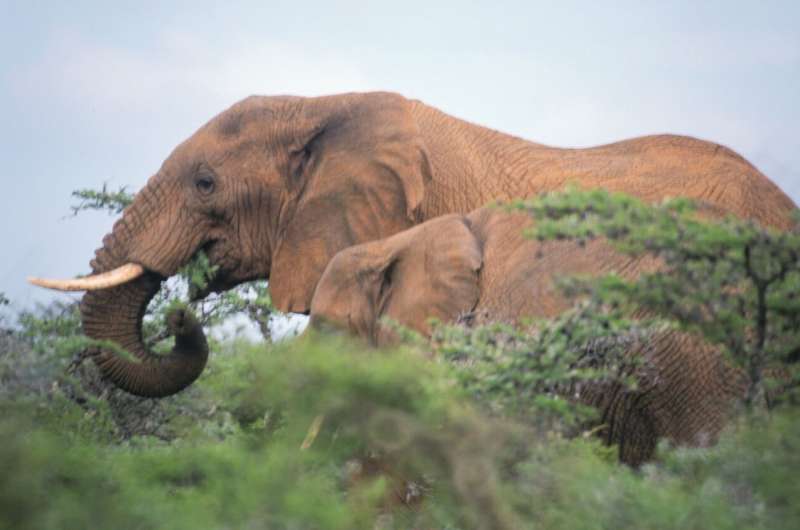
An adult and a young savanna elephant near the Mpala Research Centre in central Kenya. Credit: Frank Krell
How many dung beetles are there in East Africa? That question inspired a research project more than 20 years ago when Frank Krell was a research entomologist with the Natural History Museum London. Throughout a three-year-long project along with his wife, ecologist Sylvia Krell-Westerwalbesloh, they looked deep into the ecology of dung beetles in West and East African savannas.
Their latest research is now published in The Science of Nature.
African grasslands are dung beetle heaven. If one, lacking a restroom nearby, opts to relieve oneself behind the bushes, their waste can disappear within a half hour because of the abundance of dung beetles. But for elephants, it will take a bit longer. This led them to an interesting question: how many beetles does elephant dung attract?
When they visited the Laikipia region in central Kenya, they went to work to find out. Elephant dung is easy to find as it occurs in large heaps and often on the road. Upon locating the elephant waste, they collected two balls—also known as “boli”—and exposed one of them during the night and one during the daytime on the bare soil to see what would happen.
After half a day each, they collected the remainder of the dung and soil beneath and extracted all the dung beetles using the floating method, which is basically throwing the dung into a bucket of water: dung sinks, beetles float.
While the “day bolus” contained just over 3,300 beetles, the one exposed overnight, no longer recognizable as a bolus, harbored 13,399 dung-loving beetles. Sylvia counted them all—ecologists need stamina. All that was left of the bolus was a thin mat of dung residue.
It is known that two pounds of elephant dung serve about 13,400 beetles with food and shelter. Elephants produce on average 320 pounds of dung per day. That means that one elephant can sustain more than 2 million dung beetles on any given day.
The Laikipia-Samburu ecosystem, which hosts approximately 5,000 to 7,500 elephants, would then provide for 14 billion dung beetles in an area of over 21,000 square miles—which is about the size of Maryland and New Jersey combined.
While the African savanna elephant is not currently close to extinction in East Africa, the species is classified as threatened by the International Union for Conservation of Nature and did vanish from other parts of continent.
So, what would happen if the elephants disappeared? Some of the beetles would find other food, but the dung to support 14 billion dung beetles would cease to exist. The extinction of the majestic largest land mammal on the planet would undoubtedly have devastating effects on the billions and billions of smaller animals depending on them.
More information:
Frank-Thorsten Krell et al, One elephant may sustain 2 million dung beetles in East African savannas on any given day, The Science of Nature (2024). DOI: 10.1007/s00114-024-01894-9
Provided by
Denver Museum of Nature & Science
Citation:
One elephant can sustain more than 2 million dung beetles in east African savannas, study finds (2024, July 23)
retrieved 23 July 2024
from https://phys.org/news/2024-07-elephant-sustain-million-dung-beetles.html
This document is subject to copyright. Apart from any fair dealing for the purpose of private study or research, no
part may be reproduced without the written permission. The content is provided for information purposes only.
>>> Read full article>>>
Copyright for syndicated content belongs to the linked Source : Phys.org – https://phys.org/news/2024-07-elephant-sustain-million-dung-beetles.html










